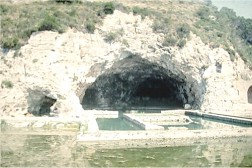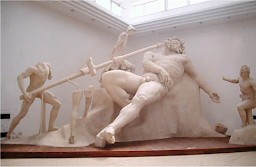Sperlonga
Q3558833Sperlonga: village on Italy's Tyrrhenian coast, famous for a cave with statues of Odysseus.

The villa of Sperlonga, built on a beach along the Tyrrhenian sea, was probably built between 30 and 20 BCE. It consisted of three parts: the villa itself, consisting of rooms surrounded a peristyle, a terrace near the beach, and a cave - the real monument. This consisted of two parts: a square basin immediately behind the entrance, and the inner cave. In the basin was a rectangular island that was used as dining room; those eating over here, could look into the inner cave, where some splendid statues were erected.
In the center of the basin was a Scylla and, behind it, deep inside the cave, an Odysseus blinding the cyclops Polyphemus. On the sides were a group showing Odysseus with the body of Achilles ("Pasquino type") and a group of Diomedes and Odysseus stealing the Palladion. In the upper part of the cave was a Ganymedes. The Scylla is signed by Athanodorus, son of Agesander, Agesander, son of Paionius, and Polydorus, son of Polydorus. These men also made the Laocoon Group.note

In 26, the dining room was the scene of an unfortunate accident, reported by Tacitus:
It happened at this time that a perilous accident which occurred to the emperor strengthened vague rumors and gave him grounds for trusting more fully in the friendship and fidelity of [the praetorian prefect] Seianus. They were dining in a country house called "The Cave," between the gulf of Amyclae and the hills of Fundi, in a natural grotto. The rocks at its entrance suddenly fell in and crushed some of the attendants; thereupon panic seized the whole company and there was a general flight of the guests. Seianus hung over the emperor, and with knee, face, and hand encountered the falling stones, and was found in this attitude by the soldiers who came to their rescue. After this he was greater than ever, and though his counsels were ruinous, he was listened to with confidence, as a man who had no care for himself.note
Today, the statues can be seen in the museum of Sperlonga, but it used to be in the cave.